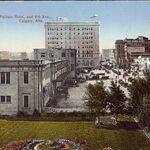Driving into the downtown core and coping with the traffic headaches of a big city can be a daunting experience. Mounting congestion is plaguing urban centres around the world as productivity is lost to people sitting idly in their vehicles. Though city planners have long recognized that the key to a smoother commute is a continual expansion and enhancement of alternative transportation modes, politicians have historically been slow to act. The implementation of a more diverse transportation network that utilizes pedestrian, transit, and bicycle infrastructure is necessary for cities hoping to escape gridlock.
The downtown cores of numerous American cities — and Canadian cities to a lesser extent — have suffered economic stagnation and physical deterioration after residents flocked to the large yards and perceived safety of post-war suburbs. These auto-centric communities have sprawled beyond traditional urban boundaries despite the broad environmental impacts associated with their expansions. But recent trends show that the suburban lifestyle is falling out of favour as downtowns rebound. People want to live close to the action again, in a central location where vehicles are not a required component of one's daily routine.
The City of Calgary, under Mayor Naheed Nenshi's leadership, has realized that as the downtown core becomes a more attractive place to live, its success depends on proper transportation choices. While local public transit projects receive a boost in funding from all levels of government, cycling is finally receiving a boost in appreciation. It's no longer viewed as merely a recreational activity, but as an integral part of moving in and out of the city. Even in a place that experiences harsh winters, where many people wouldn't even entertain the thought of a two-wheeled commute on a snowy day, Calgary pushed towards creating a well-connected downtown network of dedicated cycle tracks.
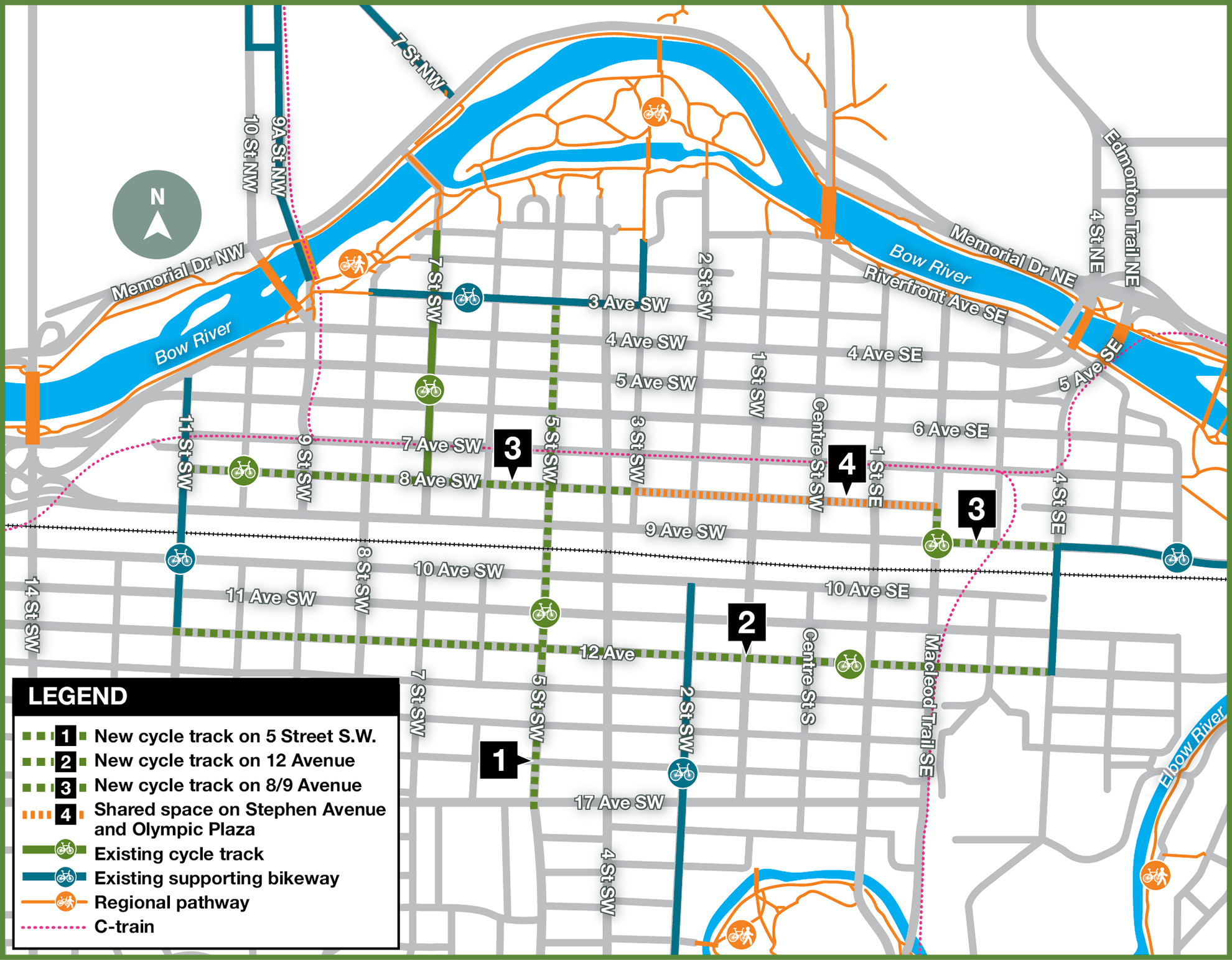 Cycle track network map, image via City of Calgary
Cycle track network map, image via City of Calgary
Calgary's downtown has seen a 122% increase in people arriving by bicycle since 1996, representing over 12,500 trips in and out of the core every day. The adoption of the city-wide Cycling Strategy in 2011 and an accompanying motion to “determine through engaging with the Cycle Community, an updated East-West-North-South separated Cycle Route Network through the Centre City" put the gears in motion for a downtown cycle track system. In April 2014, following extensive engagement with residents and a grassroots campaign led by Calgarians for Cycle Tracks, the proposed routes were approved. In June the following year, on an 18-month pilot basis, the network became a reality. Protected bike lanes now exist on stretches of 5 Street, 12 Avenue and both sides of 8 Avenue / 9 Avenue with allowances on Stephen Avenue.
We spoke with Katherine Glowacz, Active Transportation Planner with the City of Calgary, who discussed the importance of the network and its successes so far. "Building safe infrastructure for people choosing to ride a bicycle really is providing Calgarians with more transportation choices in the downtown area," said Glowacz. "Cycle tracks are community infrastructure; they’re not just for people that are commuting in and out, they’re for people that are living in the downtown community that are recreating in that area. They’re coming to see some of the cultural destinations while connecting to other parts of the city through this network."
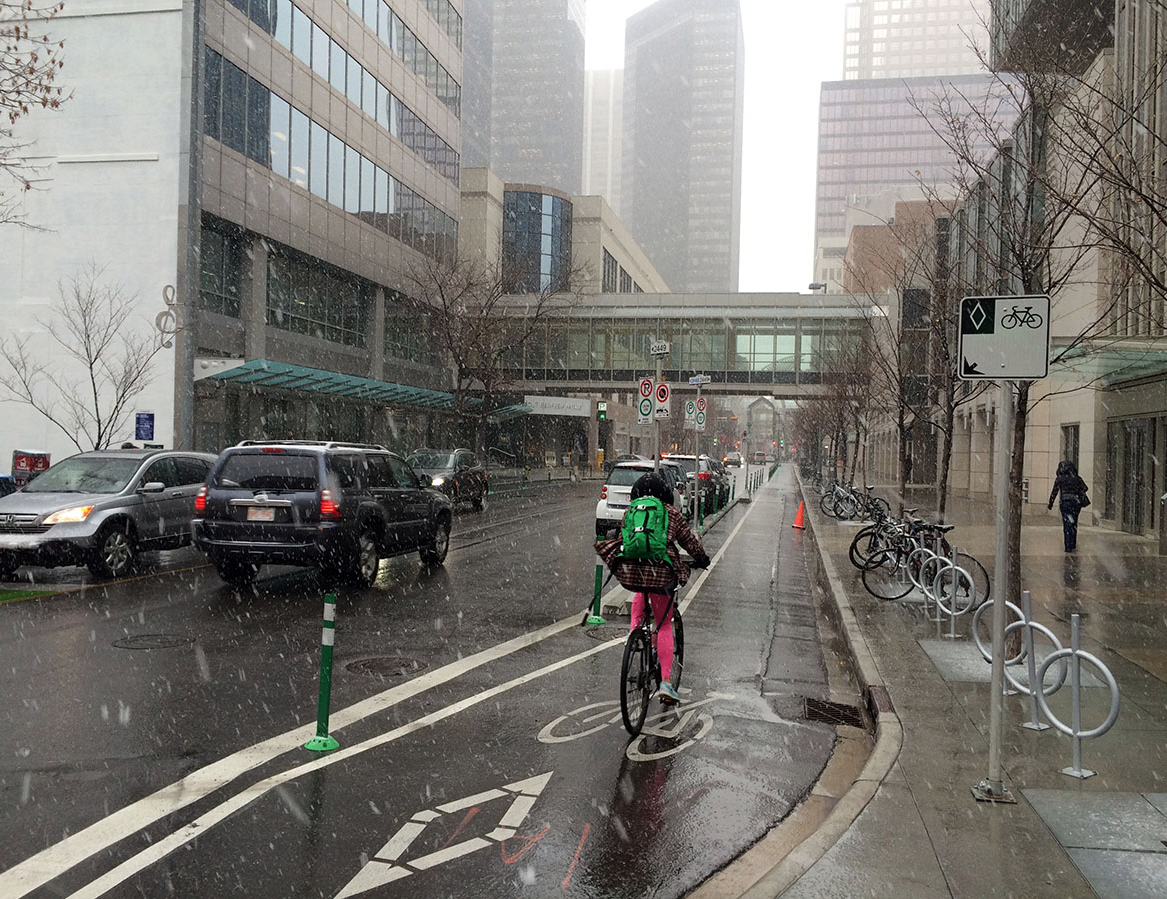 Cycle tracks installed on 8 Avenue SW, image via City of Calgary
Cycle tracks installed on 8 Avenue SW, image via City of Calgary
Though cycle tracks have drawn criticism in many major cities for taking away space from vehicles, Calgary's network aims to minimize potential impacts on other road users. "There’s always debate about changes that are happening within the city and it’s a very healthy debate to have conversations about how we plan our roadways and downtown networks," said Glowacz. "Cycle tracks provide that dedicated space to people that are biking, but the project aims to maintain space for people that are driving and walking." Glowacz explained that the City has tried to maintain parking wherever possible while also optimizing signal timing to keep traffic moving. Since the tracks are part of a pilot project, the City retains the ability to easily make adjustments and tweak the network should problems arise. "This project isn’t just about cycling," added Glowacz, "it’s about balancing all the modes."
Glowacz noted that Calgary has looked at best practices elsewhere, particularly in Europe where dedicated bike lanes are prevalent, to advise the ongoing development of their cycling system. In colder climates like Scandinavia, which boasts extensive cycle track networks in their largest municipalities, snow clearing has become second nature. Calgary's learned from this, and recognizing that cycling is a year-round transportation option for many people, the city clears its tracks in a speedy and thorough manner to maintain the network's viability.
The fate of the network will come to a vote in December 2016, when Council will decide whether to keep the cycle tracks permanently. To inform their decision, data has been constantly collected since the pilot opened. Baseline surveys were conducted in 2014 before the tracks were implemented and follow-up information has been amassed since then. Public feedback is gathered constantly through the City's 311 system. "We look at the percentage of people that are satisfied with the cycle track pilot and that’s done through a telephone survey," said Glowacz. "We look at the number of collisions along the routes, bicycle volumes and travel times for cars during peak periods, unlawful bicycle riding, demographics, etc."
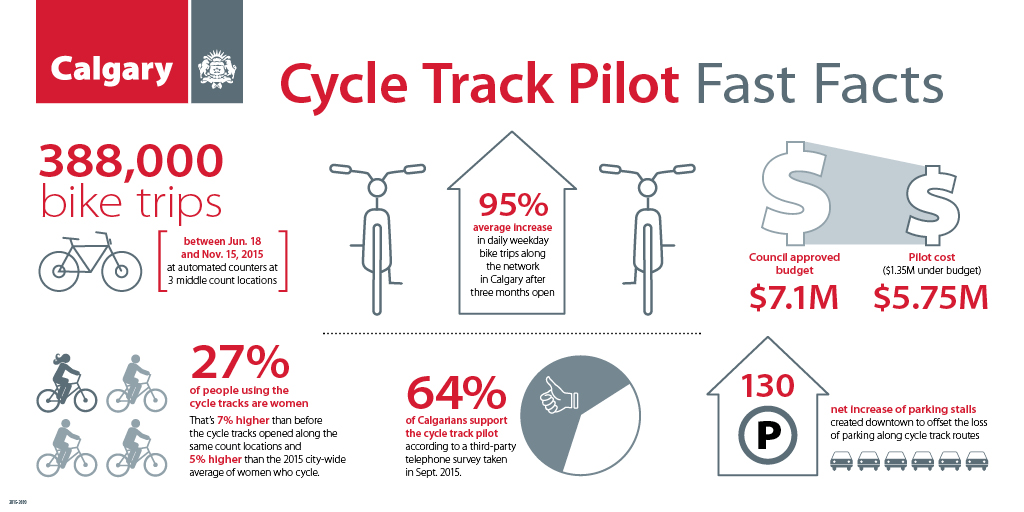 Cycle track pilot project facts, image via City of Calgary
Cycle track pilot project facts, image via City of Calgary
Numerous bike counters have been installed to track just how many people are taking advantage of this new infrastructure. Early results in December suggest a favourable outcome, with an average 95% increase in daily bike traffic along the routes measured after just three months. "Each of the ten count locations has a baseline and a target set up as part of the evaluation plan," said Glowacz. "What we’ve seen at these count locations is that where previously there was a 4.9% mode split for bicycle ridership along the street, that has gone up to 7.6% three months into the pilot." Winter ridership has also increased, and in terms of demographics, the share of women riding the system has grown from 20% to 27%. All of these numbers are key indicators of Calgary's latent demand for proper bicycle infrastructure.
While people familiarize themselves with the system, no new bike lanes will be installed downtown until after the pilot's 18-month phase is completed. Numerous other bikeways are in the works outside the core, including cycle tracks, but also less rigid infrastructure like signed routes and shared lanes. These aim to provide connections downtown but also between neighbouring communities. "There are a few coming up in the inner city area with the goal of those projects not necessarily just creating improvements for people that are cycling, but where possible creating a safer space for everyone who’s walking, biking, and driving along some of the routes," said Glowacz.
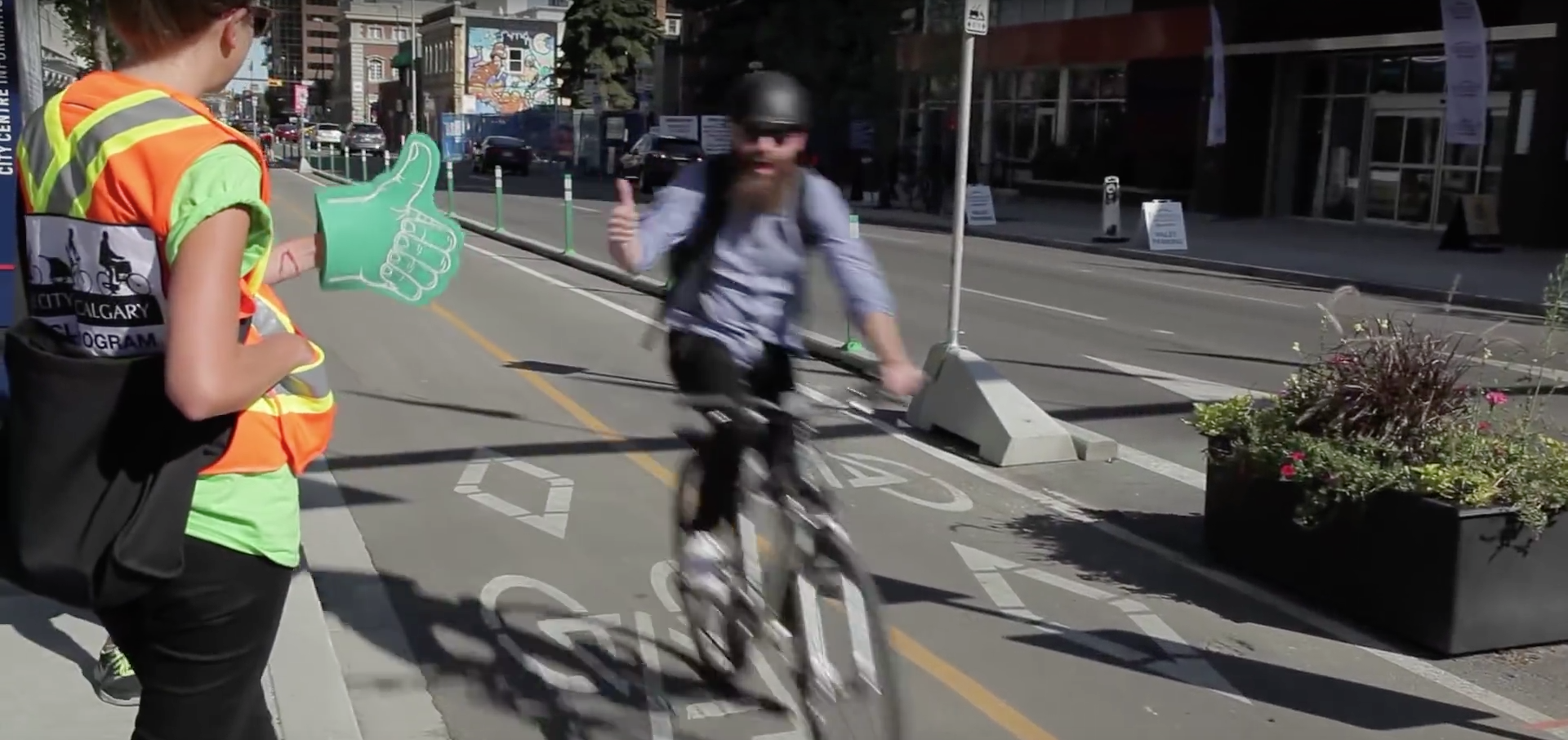 Bicycle ambassadors greet a cycle track user during the first few opening months, image via City of Calgary
Bicycle ambassadors greet a cycle track user during the first few opening months, image via City of Calgary
One of these anticipated improvements is a new two-way cycle track on Edmonton Trail NE with on-street parking additions and enhancements to the pedestrian realm. With the goal of connecting the Bridgeland and Crescent Heights communities to the existing Bow River pathway system, construction is scheduled to begin in 2017. Another project planned for 20 Street SW looks to upgrade the existing signed bicycle route into a full-fledged bike lane. That too is expected to begin construction in the coming months. With these projects about to get underway and others coming down the pipeline, the Cycling Strategy has laid the groundwork necessary to secure Calgary's path towards sustainable transportation.
The high usage and popularity of the network so far has proven that when given a safe, clear, and reliable transportation route, people will use it. By creating separated tracks and minimizing conflicts with vehicles, the City can help cyclists ride with greater purpose and peace of mind. If the largest city in oil-rich Alberta — where motorized vehicles have long been given precedence — can successfully provide cyclists with an easy way of traversing downtown streets, other cities too can shed their auto-centric image and become a model of 21st century transportation planning.
You can join the discussion about Calgary's ongoing bicycle infrastructure development by checking out the designated Forum thread. To find out more information about Calgary's cycle track network, visit the official website.

 4.6K
4.6K 




















